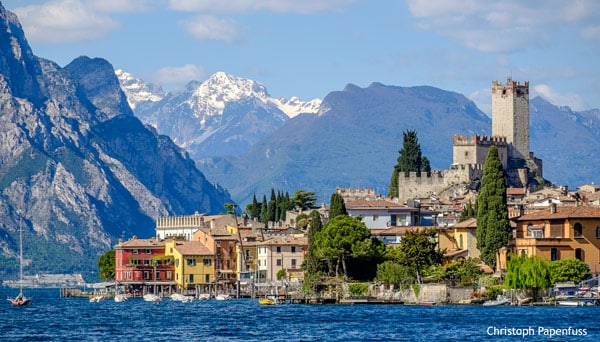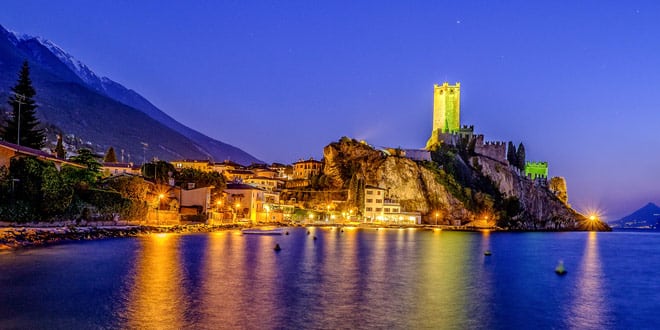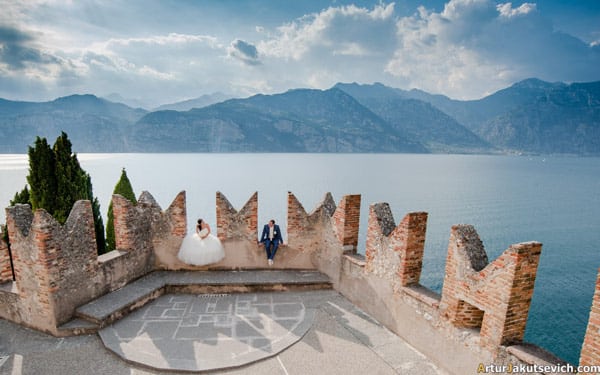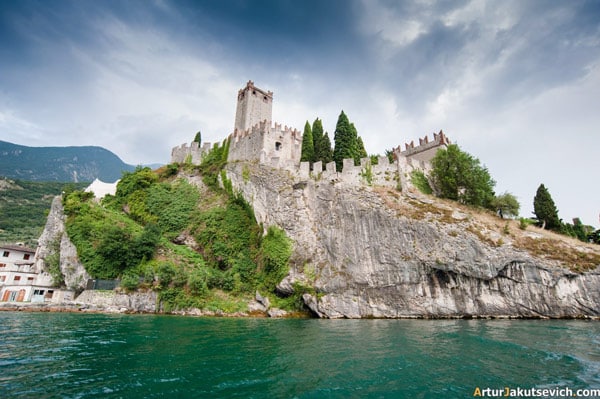In the heart of Northern Italy, in the Veneto region, on the shores of the picturesque Lake Garda, lies the small commune of Malcesine. The town attracts tourists with its bright colors, pure mountain air, and stunning lake views.
This small resort’s symbol and main attraction is the medieval Malcesine Castle (Castello Scaligero di Malcesine), which stands on a steep slope above the lake and is surrounded by beautiful panoramas.
Page Contents
History of the Castle
According to historical research, the first construction at the site of the modern Malcesine Castle was erected in ancient times (at the end of the 1st millennium BC). Subsequently, with the arrival of the Lombards in Italy, a fortress was built on this site. It underwent numerous major reconstructions and rebuildings.
After the Franks, the Hungarians captured the castle and, for some time, belonged to the Bishop of Verona. At the end of the 13th century, it was bought by a member of the Scaliger family – Alberto della Scala (Alberto della Scala). The Malcesine Castle belonged to his family for over 100 years; hence it acquired the second name – Scaliger Castle (Castello Scaligero).
Later, the building passed to the Visconti family (Visconti). From them, it went to the Venetian Republic and then under the rule of the Holy Roman Empire until the end of the 18th century. The castle briefly belonged to the French and, after Napoleon’s defeat, to the Austrians, who significantly contributed to the restoration of the medieval fortress. In 1866, Italy was unified, and the shores of Lake Garda returned to Italian ownership. In 1902, the Malcesine Castle was designated a national architectural monument.
Weddings at the Scaliger Castle
In recent decades, hosting wedding ceremonies at the castle has gained popularity. The mild climate makes the town a wonderful place to visit any time of the year. However, it is charming to be there in spring or autumn. This is precisely why loving couples from all over the world strive to come here during these seasons to have their wedding amidst the romantic backdrop of the ancient castle. The castle hosts up to 10 daily wedding ceremonies during the peak wedding season.
Wedding events can be held in one of three available venues.
- The first, for small receptions, accommodates about 40 people. This small hall offers a magnificent view of Lake Garda.
- The second option is designed for 70 guests. The walls of this hall are lined with white stone, and it is located in the castle tower.
- The third option for holding a wedding ceremony is a terrace. It faces the lake and can accommodate 80 people.
Natural History Museum
Currently, the Natural History Museum operates within the castle’s premises. It offers visitors interesting archaeological finds related to the history of the castle and the town as a whole. One section of the museum is dedicated to Johann Goethe.
This renowned figure visited the town during his travels in Italy from 1813 to 1817. Here, you can see original notes describing the castle, accompanied by sketches made by the famous writer himself. Attempting to sketch a military object, Goethe practically risked his life. Mistaken for a spy, he was even arrested. However, the publication of “Italian Journey” brought European fame to Malcesine Castle.
Museum of the History of Lake Garda and Mount Baldo
In May 2008, the Museum of the History of Lake Garda and Mount Baldo occupied nine rooms of the former fortress barracks. The museum operates daily from 9:30 am to 7:30 pm. An adult ticket costs 6 euros, while a child’s ticket (ages 6-13) is 2 euros.
- The first hall, “Depth,” immerses visitors into the heart of the lake, cutting off from the outside world and allowing a unique perspective on Italy’s largest lake.
- The second hall, “Chronology,” uses special lighting to display the entire process of Mount Baldo’s geological formation over billions of years.
- The third hall, “Lake Stratigraphy,” showcases the wild nature that once surrounded the lake. In relatively small aquariums, some fish species native to the lake are displayed.
- The fourth hall, “In the Reeds,” features lake flora and fauna in their natural habitat.
- The fifth hall, “Landscape,” allows visitors to explore the nature of Mount Baldo.
- The sixth hall, “Restaurant,” offers visitors a relaxing break with an original menu.
- The seventh hall, “History,” displays works of famous people who conducted research on the shores of Lake Garda and at the foot of Mount Baldo.
- The eighth hall, “High Mountains,” houses representatives of mountain fauna.
- The ninth hall allows one to leave feedback and share impressions of the exhibited collections.
You can find current information about opening hours and visitation costs on the museum’s official website.
The castle is surrounded by monumental crenelated walls. In the lower part of the fortress, an old amphitheater, where chamber concerts are often held, has been preserved. The most beautiful view of Lake Garda and the nearby mountains is from the balcony of the central 24-meter tower.
 Italy for me From Italy with love
Italy for me From Italy with love




